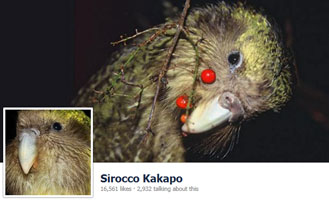The bird is the word
 Right from the first click, you can see that DOC's Facebook page has something different about it – it's hosted by a "spokesbird", Sirocco the Kākāpō.
Right from the first click, you can see that DOC's Facebook page has something different about it – it's hosted by a "spokesbird", Sirocco the Kākāpō.
As a chick, Sirocco was seriously ill and hand-reared. As a result, he thinks he's human. Because of his comfort around humans, he has regularly appeared in the public eye.
In 2010, John Key nominated Sirocco as the "Official Spokesbird for Conservation". Sirocco is now DOC's voice for all of its social media activity. Posts (and comments) are styled as if they've come from Sirocco. He must be the first kākāpō that tweets as well as "booms".
Using Sirocco as a "spokesbird" has increased DOC's public profile. He has featured on television, been in the paper, and been the subject of blogs. But Sirocco's greatest moment was appearing on the BBC's Last Chance to See programme. That programme - and Sirocco's interesting behaviour - made him infamous.
Sirocco's Facebook followers increased from 600 to more than 2000 in 48 hours after his starring role on Stephen Fry's show. The clip from the show featuring Sirocco had 5,098,203 views, as at 2 May 2013. Like most celebrities, you can even read Sirocco's memoir – Sirocco the Rock-star Kākāpō!
What is DOC doing?
DOC uses a number of techniques on its Facebook page, aimed at capturing the attention of the public. These techniques include:
- choosing a unique username;
- capturing people's attention through stimulating images and videos and a relevant profile picture; and
- posting content that is useful and entertaining.
Jan Zimmerman and Deborah Ng (two social media authors and practitioners) say that engaging content has:
- photos that are relevant, thought-provoking, discussion worthy, and amusing;
- content that makes people laugh;
- heart-warming stories, including tales of success or comebacks; and
- updates that are short and sweet.
You only have to read one post on Sirocco's Facebook page to see these techniques at work.
Why focus on DOC?
We recently carried out a Facebook "mystery shop" of New Zealand public entities. We sampled 78 entities, of which 44 had Facebook pages. We looked for evidence that the techniques we listed above, plus other recognised ways to increase engagement such as apps and tabs, were being used. We recorded the number of page "likes", post "likes", comments, and shares. We also looked at:
- the total number of page "likes"; and
- how many "likes" each post tended to generate (we sampled the last five posts and took an average).
The table below shows the eight public entities in our sample with the most page "likes". DOC ranks 7th on page "likes", but 3rd on post "likes".
| Organisation | Page "likes" | Average post "likes" | Leverage* |
|---|---|---|---|
| NZ Tourism | 727,230 | 3967 | 5 |
| Air New Zealand | 351,417 | 696 | 2 |
| New Zealand Fire Service | 27,515 | 288 | 10 |
| Te Papa | 27,377 | 96 | 4 |
| NZ Blood Service | 19,427 | 141 | 7 |
| TVNZ (One News) | 18,101 | 21 | 1 |
| Department of Conservation | 16,196 | 615 | 38 |
| Massey University | 14,504 | 15 | 1 |
* We defined leverage as the ratio of post "likes" for every thousand page "likes". All figures taken from Facebook on 2 April 2013.
If we assume that liking a post indicates deeper engagement than liking a page, then DOC's page is interesting because it has managed to leverage more engagement from a smaller "like" base.
If you're interested in learning more about our mystery shop results, keep watching. We'll share the results, as they develop, in future blog posts.
